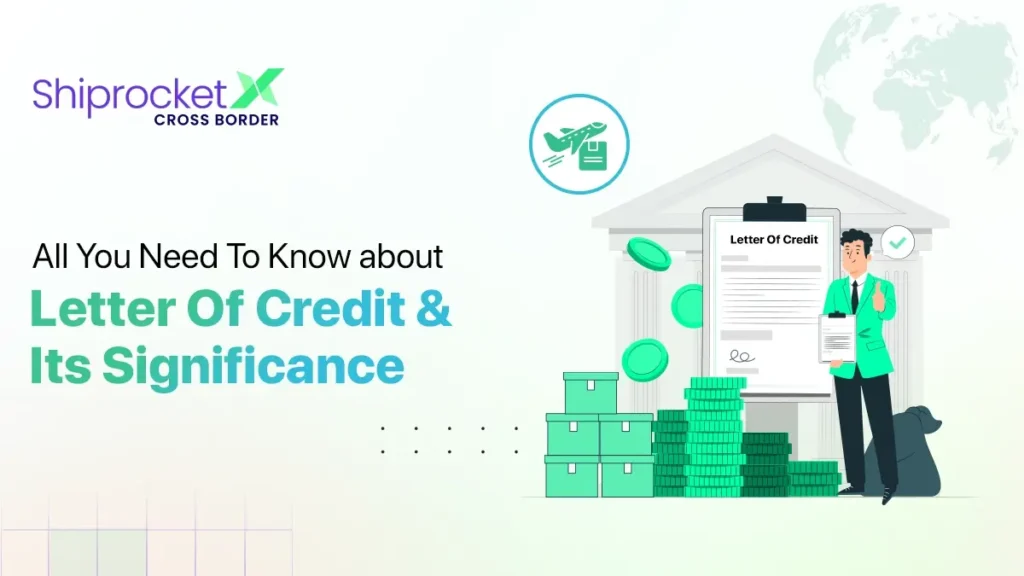Letter of Credit: Types, Benefits, and Process Explained
- Letter of Credit: How It Works and Who’s Involved?
- Types of Letters of Credit
- Real-World Examples – Putting Letter of Credit into Context
- Discount Rates and Guarantees
- Applying for a Letter of Credit: Step-by-Step Guide
- Pros and Cons of Letter of Credit
- Commercial vs. Revolving: Knowing the Difference
- Payment Process: When and How Payments Occur?
- Simplifying Global Trade with ShiprocketX
- Conclusion
A letter of credit works as a reassurance for the seller. It confirms that the buyer will make complete and timely payment for the goods and services he has availed from the seller/service provider. It has become an essential document when it comes to international trade as it helps safeguard the interests of buyers and sellers. Statistics reveal that the letter of credit confirmation market size increased to USD 4.5 billion globally in 2023. The market is expected to grow further and reach USD 6.2 billion by 2032.
The letter is often offered as a FACILITY (Financial Assistance that is Essentially a Loan) by the bank. As there is substantial risk involved in this arrangement, banks conduct an extensive background check on the buyers and state clear consequences for not making the payment. Different types of letters of credit come with different clauses. In this article, you shall learn at length about the letter of credit, their types, how this concept works, and its advantages and disadvantages.

Letter of Credit: How It Works and Who’s Involved?
A letter of credit is issued to affirm that a buyer shall make a timely payment (in full or as decided) to a seller. It is issued by the bank. In case a buyer fails to make the payment, the bank is liable to do so on his/her behalf. The bank may be required to pay directly to the beneficiary or any bank or financial institution nominated by the beneficiary. In case the letter is transferable, then the beneficiary may ask the bank to make the payment to another entity.
The letter has immense significance in international trade because of the varied laws in each country and the barriers to learning about the genuineness of different parties. Here, the buyer of the goods is mostly the importer. He works with the bank to provide the letter to the exporter who happens to be the beneficiary or the seller.
A buyer is mostly expected to make a partial payment at the time of placing an order and the remaining payment after the exporter ships the items and shares relevant shipping documentation. Buyers who make bulk purchases mostly require this document and the bank issues it as a guarantee to the seller. Before issuing the letter, the bank does a thorough background check of the buyer and does all the essential paperwork to make sure the latter does not back off. A buyer requires proving that he is financially sound to make the payment to the seller and won’t act contrarily when the time comes.
Types of Letters of Credit
There are mainly eight different types of letters of credit. Here is a look at what each one of them offers:
- Commercial Letter of Credit
This type of letter is issued to guarantee direct payment to the seller. This means that the bank issuing the letter is liable to make the payment to the seller directly after the dispatch of the goods or as decided.
- Standby Letter of Credit
This letter serves as a backup plan for the buyer. In case the buyer is unable to make the payment for the goods and services offered by the seller, the latter can demand the same from the buyer’s bank by producing this letter. The issuing bank requires making the payment on the buyer’s behalf in this case.
- Revolving Letter of Credit
This type of letter enables the buyer to draw the amount multiple times during a particular period. This is mostly issued when the buyer requires dealing with frequent shipments. It shuns the need to draft and submit the letter frequently.
- Revocable Credit
This allows the issuing bank to rectify or change the terms and conditions of the letter of credit at its discretion. It is not liable to send any prior information to the beneficiary before making these changes.
- Transferable Credit
This letter of credit enables the bank to transfer the decided amount to another entity upon receiving a request from the beneficiary.
- Traveller’s Letter of Credit
This letter acts as a guarantee that the bank issuing it shall honour the drafts at some of the foreign banks.
- Confirmed Letter of Credit
It serves as a confirmation of the creditworthiness of the issuing bank. A confirmed letter of credit is issued by the advising bank with reference to the letter of credit by the issuing bank. In this case, the advising bank undertakes the responsibility of paying the seller in case the buyer or the issuing bank fails to do so. This offers added security to the seller.
- Sight Letter of Credit
Also referred to as Usance Credit, a sight letter of credit enables the beneficiary to claim the payment from the issuing bank by showing necessary documents.
Real-World Examples – Putting Letter of Credit into Context
Here are some real-world examples of letters of credit issued by banks:
ICICI Bank: ICICI issues letters of credit that are accepted globally. It has a stronghold in the global market because of its widespread network of correspondent banks around the world.
Citibank: The bank provides letters of credit to buyers operating in the Middle East, Latin America, Asia, Eastern Europe, and Africa. It is issued to help them access international credit. It is helpful for the exporters as it helps minimise financial risk in the importer’s country. Likewise, it also lowers the issuing bank’s commercial credit risk.
HDFC Bank: HDFC Bank issues different types of letters of credit to encourage international trade and build trust among buyers and sellers.
Discount Rates and Guarantees
As already mentioned, the letter of credit is issued as a guarantee by a bank to a seller. A confirmed letter of credit is issued by a bank of repute as a guarantee of the creditworthiness of the issuing bank. But what are discount rates in the context of a letter of credit? Well, some of these letters have a discount rate. These are the letters that are arranged by a broker. Here, the broker earns a commission which is the difference between the complete value mentioned on the LC and the actual available amount.
Applying for a Letter of Credit: Step-by-Step Guide
Applying for the Letter of Credit and obtaining it is a two-step process. Here is a look at the same:
Step 1: After completing the sales agreement, the importer is required to apply for a letter of credit in favour of the exporter. The exporter should be satisfied with the genuineness of the bank chosen by the importer for the issuance of the letter.
Step 2: The importer’s bank drafts the letter of credit based on the terms shared in the sales agreement and shares it with the exporter’s bank. The letter is reviewed at the latter’s bank and is sent to him/her after approval.
Pros and Cons of Letter of Credit
Pros
- An LC helps create mutual trust among buyers and sellers, and encourages trade.
- It streamlines the process of transfer of funds.
- You have the flexibility to customise the terms and conditions of this letter to suit your specific circumstances and needs.
Cons
- Drafting an LC can be a time-consuming task.
- It adds to the expense of the buyers as they have to pay for the issuance of LC.
- The letter may not include every single detail of the transaction that may lead to error.
- It may not account for a sudden change in the economic or political situation of a country.
Commercial vs. Revolving: Knowing the Difference
As per Commercial LC, the bank requires paying directly to the beneficiary. It is one of the most widely used forms of letter of credit. Contrarily, a Revolving LC enables buyers to make multiple payments within a particular time frame.
Payment Process: When and How Payments Occur?
Here is how and when the payment occurs:
- The exporter sends the shipment as mentioned in the LC in addition to submitting the relevant documents to its bank.
- The documents are duly checked with reference to the conditions mentioned on the LC. In case they do not comply with the decided terms, then they need to be amended and resubmitted. Once approved, they are sent to the importer’s bank.
- On receiving the required documents, the payment is released by the importer’s bank. Thereafter, the bank releases the documents to enable the importer to clear customs and claim the goods.
The amount of time taken in the process varies in each case.
Simplifying Global Trade with ShiprocketX
ShiprocketX is here to streamline global trade for seasoned businessmen and start-up owners. We have an exclusive international shipping platform to simplify global trade for you. We customise shipping services to match your specific needs for a seamless experience. You can ensure your international shipment reaches its destination within 8 days by opting for our priority delivery service. Urgent shipments can be delivered in as little as 4 days as opposed to our usual deliveries that take around 10-12 days to reach. Our team helps with the customs clearance process and maintains transparency in transactions.
Conclusion
A letter of credit is deemed an important document, especially in international trade. The letter of credit confirmation market size is anticipated to grow at a CAGR of 3.48% between 2024 and 2032. There are different kinds of letters of credit. These include Confirmed LC, Usance Credit, Traveller’s LC, Revocable LC, Transferable Credit, Stand by LC, Commercial Letter, and Revolving LC. Banks act as a bridge between the buyers and sellers by issuing this letter as a guarantee that the buyer will make the payment promptly. In case a buyer fails to do so, the bank being the guarantor bears the liability. Applying for the letter can be a tedious process; however, it is worth the effort as it helps expand trade. It is advised to understand the terms and conditions related to the same and the possible cons associated with it before opting for it. The information shared above should help in this regard.






